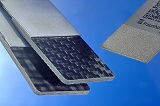
Innovative Joining Technology for High-Performance Hybrid Parts

Laser-based joints of steel (1.4301) with different thermoplastic composites (CFRP, GFRP)
Institute for Composite Materials (IVW)
Aim of the international project FlexHyJoin, funded by the European Union’s program for research and innovation “Horizon 2020”, is the novel development of a fully automatized joining process for the automotive industry. Its objective is to enable rapid manufacturing of hybrid metal/thermoplastic-based fiber reinforced polymer composite (TP-FRPC) parts.
Hybrid components play an essential role in vehicle weight reduction and facilitate the materials’ full potential exploitation. Particularly metal/TP-FRPC multimaterials are very promising for this purpose, as TP-FRPC materials offer high specific mechanical properties and excellent chemical/corrosion resistance.
However, a satisfying joining method for metal and TP-FRPC parts does not exist until now, ensuring a high mechanical bonding performance without employing additional material and simultaneously possessing an adequate level of automation.
Precisely this approach represents the project’s core: Both induction joining and laser joining are combined in a fully automatized production cell. These two indicatory technologies perfectly complement each other concerning their particular fields of application.
Implementing innovative surface textures enables gapless form closure and improved adhesion in automotive components without requiring any additional material, such as adhesives.
By combining the surface treatment with the complementary induction joining and laser joining, as well as integrating the complete equipment with an on-line process control, a very high degree of automation and significant reduction in the manufacturing-critical cycle time can be achieved.
Thus, FlexHyJoin will support the industry-wide usage of metal/TP-FRPC hybrid components in automotive mass production.
The project was launched in October 2015 with a successful kick-off meeting in Brussels. Until December 2018, ten contributing partners from five countries are cooperating within the FlexHyJoin consortium.
CRF Centro Ricerche FIAT S.c.p.A., Italy
EDAG Engineering GmbH, Germany
FILL Gesellschaft m.b.H., Austria
Fraunhofer ILT, Germany
Fundación Tecnalia Research & Innovation, Spain
HBW-Gubesch Thermoforming GmbH, Germany
Institut fuer Verbundwerkstoffe GmbH (Project Coordinator), Germany
KGR S.p.A., Italy
Leister Technologies AG, Switzerland
New Infrared Technologies S.L., Spain
This project has received funding from the European Union’s Horizon 2020 research and innovation program under grant agreement no. 677625.
Contact information:
Dr.-Ing. Birgit Bittmann
E-Mail: birgit.bittmann@ivw.uni-kl.de
Phone: +49 631 2017 427
Nora Feiden
E-Mail: nora.feiden@ivw.uni-kl.de
Phone: +49 631 2017 249
Christoph Engelmann
E-Mail: christoph.engelmann@ilt.fraunhofer.de
Phone: +49 241 8906-217















